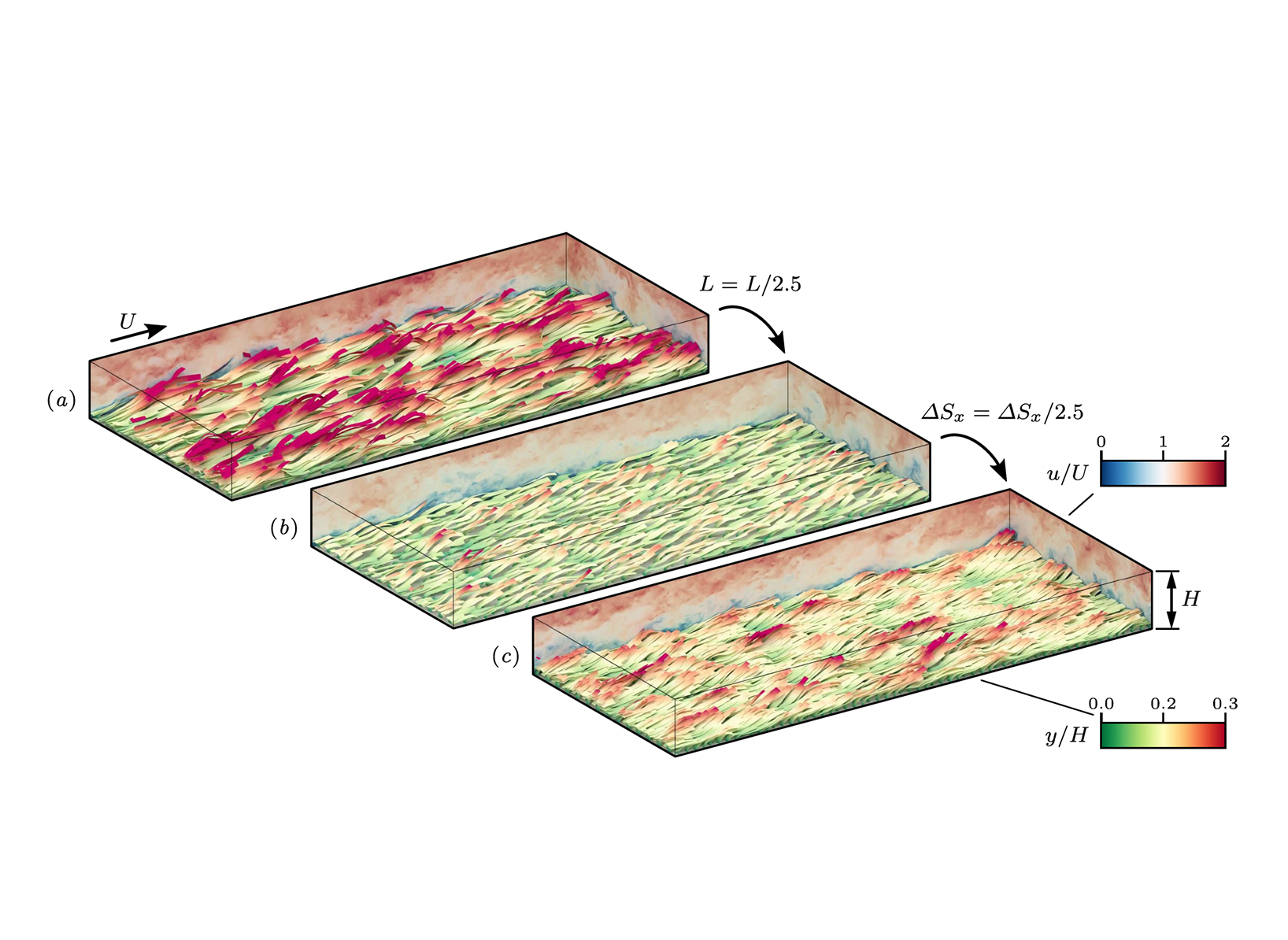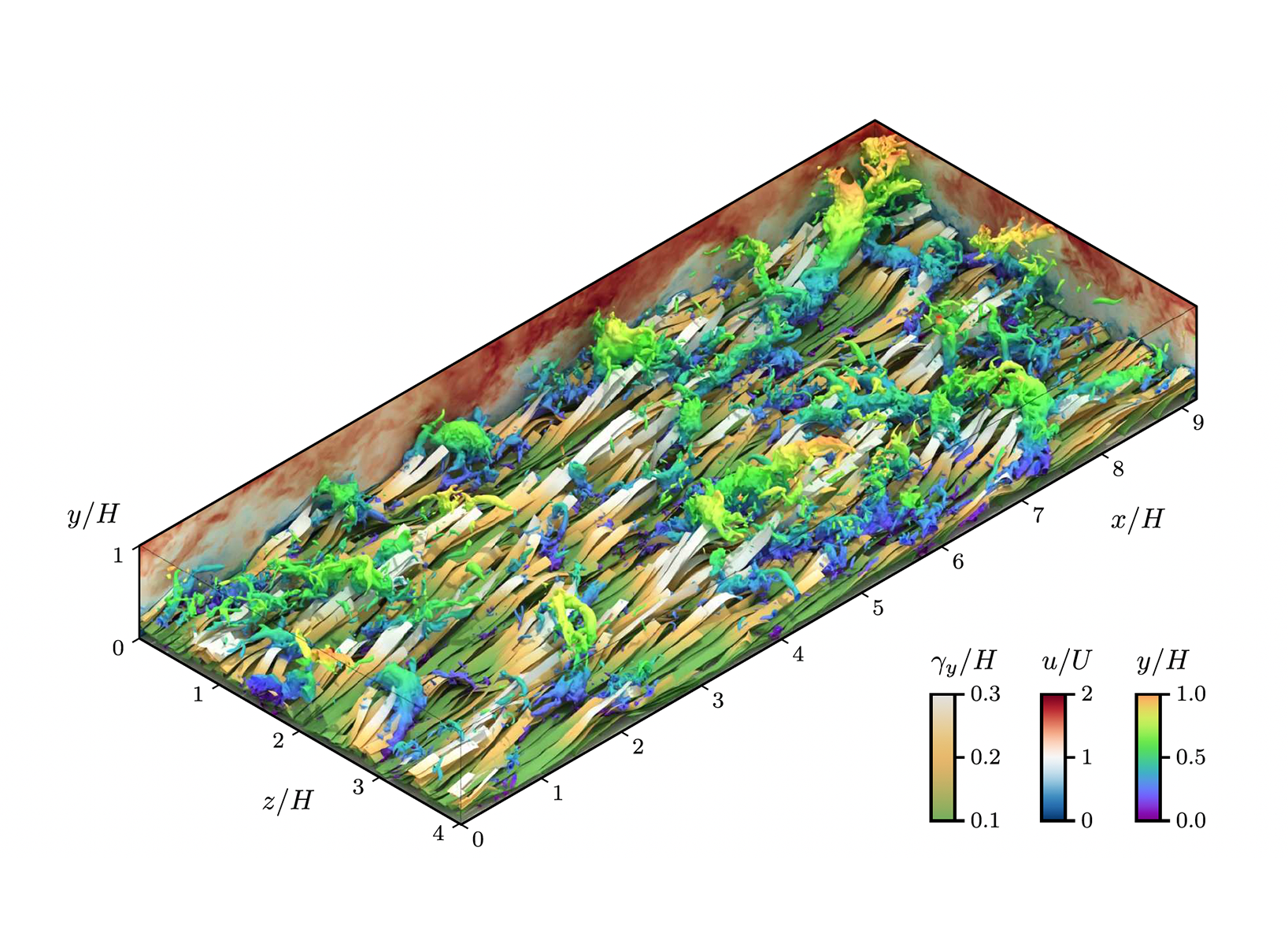Project
Investigation of Fluid Structure Interaction (FSI) in abstracted canopies inspired by aquatic vegetation using Large Eddy Simulations
The turbulent flow over and through modelled aquatic canopies similar to seagrass meadows is investigated using scale-resolving numerical simulations. The aim of the study is to reveal detailed information on the interaction between the flow and the flexible structures constituting the canopy.
Project Details
Project term
September 22, 2023–September 21, 2024
Affiliations
Technische Universität Dresden
Institute
Institute of Fluid Mechanics
Principal Investigator
Methods
Simulations were carried out using the code PRIME developed at the Institute of Fluid Mechanics, TU Dresden. It employs a spatially and temporally second-order finite volume method solving the Navier–Stokes equations for incompressible fluids. A specialized immersed-boundary method (IBM) enables the coupling with the Cosserat rod equations describing the motion of the ribbon-shaped canopy elements. Collisions between these individual ribbons are represented by appropriate contact forces acting locally on the ribbons. Periodic boundaries were commonly applied in horizontal directions to achieve the same conditions as in a patch that is part of a very long and wide canopy.
Results
Starting in the previous project period (01/2023 – 08/2023), homogeneous canopy cases were simulated, including sensitivity analyses, and the variation of different canopy properties. An illustration is given in figure 1. These simulations were continued in the following year (09/2023–09/2024, reporting period), with evaluations of the timeresolved data being further developed. The main results stem from a case derived from the experimental investigation in [5]. It consists of 672 highly flexible ribbons, henceforth also referred to as blades. The flow is turbulent, with a bulk Reynolds number of 20 000. The high flexibility of the blades is reflected by an elevated Cauchy number of 25 000. A snapshot from this simulation is shown in figure 2. Contrary to cases with less flexible plants, as studied in [13], the movement of the ribbons is very pronounced vertically, and even more so in the spanwise direction, when characterized by the motion of their tips. The blades also twist frequently and exchange momentum by mutual collisions. Substantial interaction between the canopy and the flow was found, including an increase in drag by a factor of 12 compared to the same channel flow without vegetation. At the same time the motion of the blades is well correlated with the streamwise velocity, so that the patterns developing at the canopy–flow interface reflect the larger flow structures passing by. For these flow structures, a staggered pattern was seen to be prevalent. Conditional averages were collected to isolate events where the canopy is locally very shallow, and events where the blades are significantly more upright than on average. Thinning and thickening of the canopy is related to vertical flow over the edge of the canopy, so that this creates exchange between the portion of flow inside the canopy and the exterior.
Discussion
The investigations followed the plan established in the ANR–DFG project ESCaFlex (ANR-16-CE92-0020, DFG grant 634058). During the reported compute time period it was possible to obtain results required for a conclusive manuscript recently submitted, [9], and presently under review. The present method offers a wide amount of future prospects. Ongoing simulations include cases where the geometric properties of the blades and their arrangement are varied. Initial results show an impact on patterns forming in the canopy–flow interface. Another perspective is to consider canopy patches. A first case was studied using streamwise patches and moderately stiff blades [8]. Finally, it is interesting to consider variants where the flow is modified, since the canopy–flow interface interacts with the outer flow. One such modification is a case with sidewalls where secondary flow features related to the geometry of the channel play a role. Corresponding simulations have been conducted and are being pursued [7].
Additional Project Information
DFG classification: 404-03 Fluid Mechanics
Software: GCC, PETSc library, HYPRE library, NumPy, ParaView, Colorcet, Nfft, Scipy, Matplotlib, Pandas, Pytables, YAML, Numba, Mpi4py, Scikit-Image
Cluster: CLAIX
Publications
[5] L. Guiot De La Rochére, D. Doppler, J. J. S. Jerome, B. Löhrer, J. Fröhlich, and N. Riviére.
“Individual and Collective Plants Motion in a Submerged, Staggered, Flexible, Artificial Canopy”. In: River Flow 2022. Kingston and Ottawa, Canada (online): CRC Press, Nov. 8–10, 2022. doi: 10.1201/9781003323037-105.
[6] B. Löhrer, D. Doppler, L. Guiot de la Rochére, N. Rivére, and J. Fröhlich.
“Large-Eddy Simulation of the Fluid–Structure Interaction in a Confined Aquatic Canopy Consisting of Highly Flexible Blades”. in preparation.
[7] B. Löhrer, D. Doppler, S. Puijalon, N. Riviére, J. J. S. Jerome, and J. Fröhlich.
“A First Simulation of a Model Aquatic Canopy at High Cauchy Number”.
In: Proceedings of the 10th Conference on Fluvial Hydraulics (Delft, Netherlands, 7-10 July 2020).
London: CRC Press, 2020, pp. 152–158. doi: 10.1201/b22619.
[8] B. Löhrer and J. Fröhlich.
“Large Eddy Simulation of the Flow over a Canopy with Spanwise Patches”.
PAMM (2023), e202300256. doi: 10.1002/pamm.202300256.
[9] B. Löhrer and J. Fröhlich.
“Large-Eddy Simulation of the Fluid–Structure Interaction in Aquatic Canopies Consisting of Highly Flexible Blades”. Journal of Fluid Mechanics (submitted).
[10] B. Löhrer, J. J. S. Jerome, S. Barsu, N. Riviére, D. Doppler, and J. Fröhlich.
“Velocity Field in a Single Row Canopy Made of Flexible Blades for a Static Reconfiguration Case and a Monami Case”. In: Proceedings of the 10th Conference on Fluvial Hydraulics (Delft, Netherlands, 7-10 July 2020). London: CRC Press,
2020, pp. 159–166. doi: 10.1201/b22619.
[11] B. Löhrer, R. Krause, and J. Fröhlich.
“A Collision Model for Very Flexible Cosserat Rods and Immersed Boundary Fluid–Structure Coupling”.
Multibody System Dynamics (submitted).
[12] K. Schoppmann, B. Löhrer, S. Tschisgale, J. Fröhlich, and E. de Langre.
“An Efficient Solver for a Cosserat Rod of Non-Constant Width Applied to a Problem of Fluid-Structure Interaction”. Proceedings in Applied Mathematics and Mechanics 21.1 (2021), e202100152. doi: 10.1002/pamm.202100152.
[13] S. Tschisgale, B. Löhrer, R. Meller, and J. Fröhlich.
“Large Eddy Simulation of the Fluid–Structure Interaction in an Abstracted Aquatic Canopy Consisting of Flexible Blades”. Journal of Fluid Mechanics 916 (2021), A43. doi: 10.1017/jfm.2020.858.
Thesis:
[14] K.-M. Bornemann.
“Numerical Investigation of Turbulent Flow over and through Inhomogeneous Canopies”.
Diplomarbeit. Dresden, Germany: TU Dresden, 2020.
[15] M. R. D. Brandt.
“Parallelisierte Visualisierung von Wirbelstrukturen”.
BA thesis. Dresden, Germany: TU Dresden, 2019.
[16] L. Mastrangelo.
“Analysis of Splat and Antisplat Events in the Flow over Aquatic Canopies Based on Data from Large Eddy Simulations”. MA thesis. Rome, Italy: Sapienza Universitá di Roma, 2022.
[17] K. Schoppmann.
“Entwicklung eines effizienten Lösers für die Bewegung langer, flexibler Strukturen veränderlicher Breite”.
Diplomarbeit. Dresden, Germany: TU
Dresden, 2020.
[18] S. Tschisgale.
“A Numerical Method for Fluid-Structure Interactions of Slender Rods in Turbulent Flow”.
Doctoral Thesis. Dresden, Germany: TU Dresden, 2020.
https://nbn-resolving.org/urn:nbn:de:bsz:14-qucosa2-387063
[19] F.Wollny.
“Entwicklung einer automatisierten Testumgebung für den Strömungslöser PRIME”.
Diplomarbeit. Dresden, Germany: TU Dresden, 2020.
 Figure 1: Illustration of the three physical models investigated, showing snapshots of the numerical solution. (a) Base configuration; (b) derived configuration with shorter blades; (c) derived configuration with shorter, but also more densely placed blades.
Figure 1: Illustration of the three physical models investigated, showing snapshots of the numerical solution. (a) Base configuration; (b) derived configuration with shorter blades; (c) derived configuration with shorter, but also more densely placed blades.  Figure 2: Visualizations of an instantaneous snapshot from the base configuration. The figures shows the geometry of the canopy blades coloured by their surface height y, the streamwise velocity u in vertical slices, and iso-pressure surfaces with p′ = −0.1pU2 = const., coloured by y. Figure from [9].
Figure 2: Visualizations of an instantaneous snapshot from the base configuration. The figures shows the geometry of the canopy blades coloured by their surface height y, the streamwise velocity u in vertical slices, and iso-pressure surfaces with p′ = −0.1pU2 = const., coloured by y. Figure from [9].